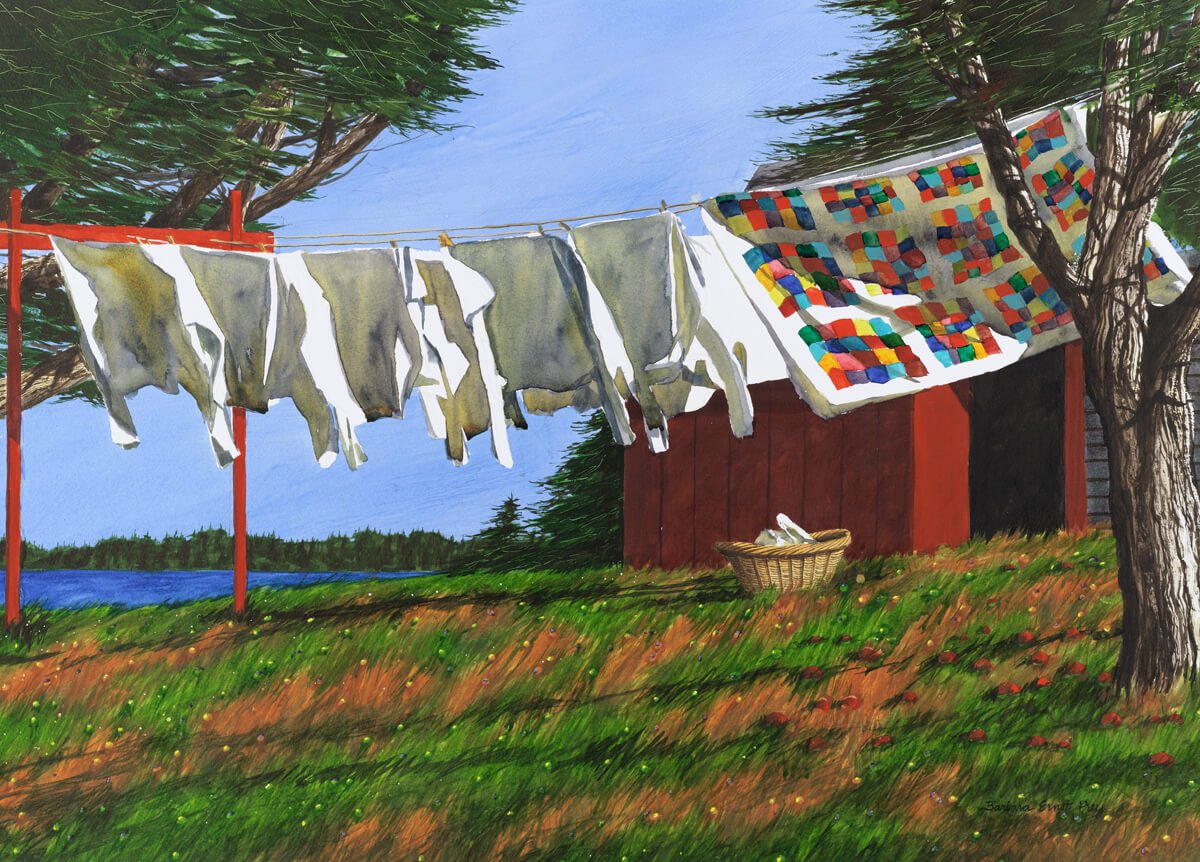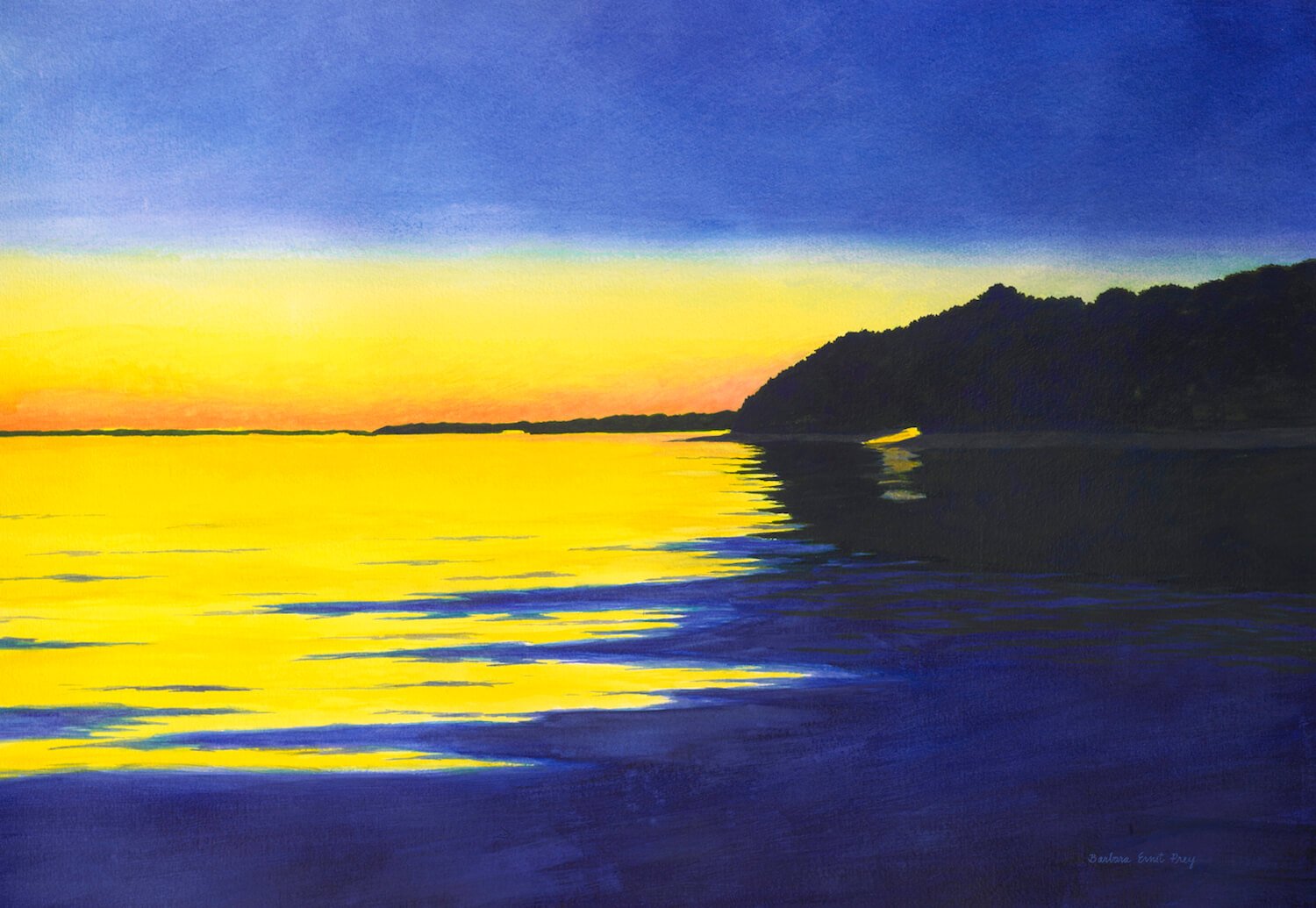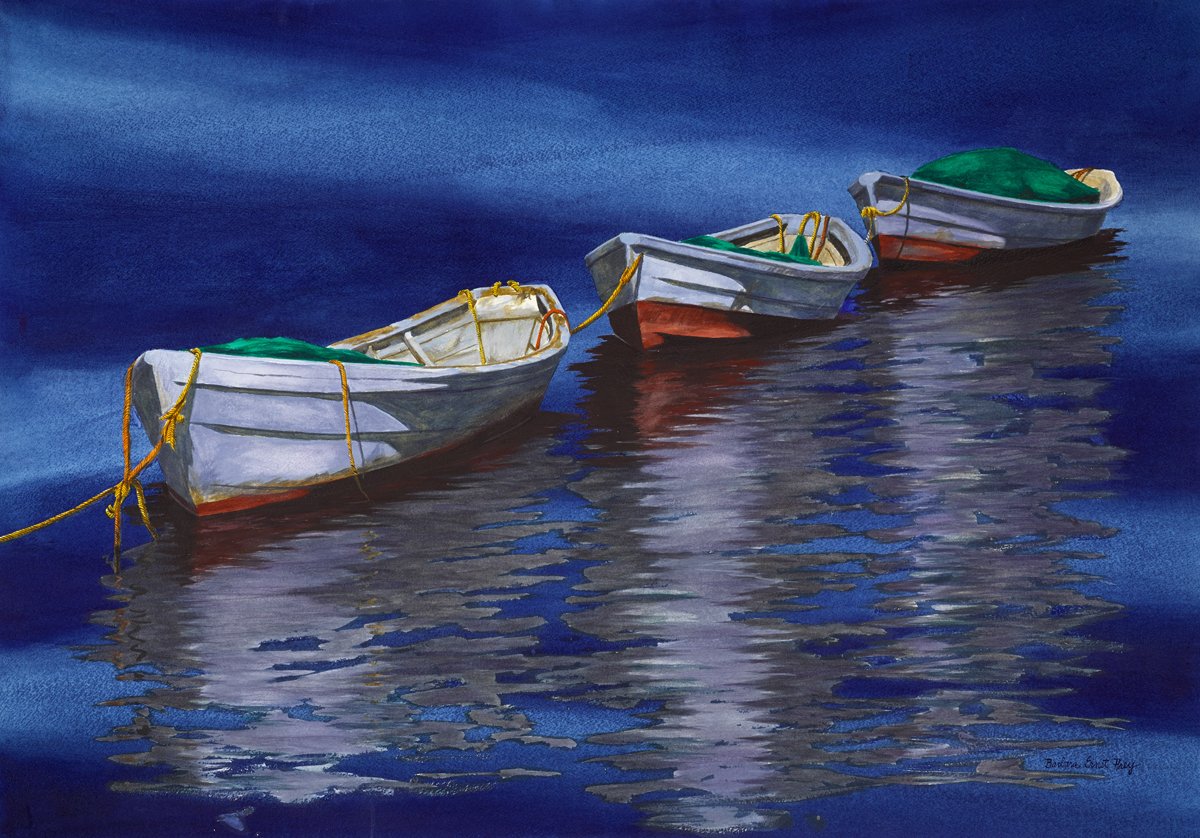A Colorful Life: Barbara Prey Paints Landscapes that Reflect Both an Inner and Outer World
AMERICAN ARTS QUARTERLY
by David Masello
White Wash, 2014 22 x 30 inches
The moment Barbara Ernst Prey applies a brushstroke to paper, the swath of color she leaves behind is something simultaneously both brand new and old. “I paint every day with my mother’s brushes,” the artist says from her bright third-floor studio in the turret of a Victorian house on Long Island’s North Shore. “My mother was head of the design department at Pratt (Institute) and she knew to take very good care of her brushes. I really can honestly say that I feel her spirit in them. We would often paint together, en plein air especially, and those brushes I watched her work with, I now work with.”
Prey’s brushes are always in action, especially as she applies watercolors to large surfaces of paper—the medium for which she is best known. Prey may be one of America’s most visible artists, in that her work is shown not only in galleries and museums, embassies and presidential libraries on earth, but also, in a way, in outer space. Among her vast palette of awards and accolades, Prey was commissioned by NASA to execute paintings for their permanent collection—ones that virtually redefine life on this planet. Her depiction of the Columbia astronauts who perished in the disaster in 2003, along with works showing the international space station and the shuttle Discovery are part of the NASA Art Program tradition, one in which Norman Rockwell and Robert Rauschenberg were also invited and participated.
There are few artists working today of whom people ask for their autograph, but Prey is one of them. And she is used to being among the well known and well-pedigreed (collectors of her work include members of the Mellon, Rockefeller and Phipps families). President George Bush commissioned her to paint the official White House Christmas card and when Prey was only seventeen, she sold two works to then New York Governor Hugh Carey. Her paintings, chiefly landscapes, which she insists “hover between representation and abstraction,” are decidedly accessible and beautiful, certainly the best attributes of any good representational art. When asked why her typical large-scale scenes stand out from other artists who might paint similar scenes—rowboats bobbing in a harbor, winter sunsets in Maine, the interiors of New England meeting houses coursed by beams of sunlight, American vernacular houses on country roads, marshlands, fields ablaze with autumnal color—Prey says, matter-of-factly, “I like to think my work is really good. I’ve been described as an artist’s artist, though I know I wouldn’t be regarded as that were it not for my mother. She had such high standards for her art. I grew up in such an artistic home, with my mother hanging reproductions all over and taking me to all of the museums. I wouldn’t be the artist I am today without those experiences. My mom really helped inform my vocabulary.”
But still, Prey’s fame and sheer popularity as an artist derives from other traits, too, the chief one being her use of color. While watercolors are often noted for their muted cast on paper, Prey’s works dazzle with color, as if she is some kind of alchemist of the medium, able to transform a particular hue into a bolder, deeper, almost three-dimensional version of itself. “My work is all about color,” she admits. “Color speaks to your soul. No one else does what I do, which is use a saturation of color. I’ll labor on a work, applying layers and layers—not only of color, but also meaning.”
Indeed, the hues of a patchwork quilt drying on the line in her White Wash, the blocks of colors of grasses fronting the lighthouse in Quadricentennial and the cobalt water and bright yellows of her Bonfire are so dense with hue that the works verge on becoming something unreal, not of this world, yet they remain rooted in reality. “I’m always pushing with the colors,” says Prey, “but also taking on traditions and staying true to them, akin to Winslow Homer.” She recalls an early admiration for the works of Maxfield Parrish, a colorist extraordinaire. “But when I really started looking at his works up close, I thought, no, the colors can be too strong. Of course, he was an illustrator, too, and that’s the reason for some of his overuse of color.”
Meeting House, 2012 21 x 28 inches
As for her preferred medium of watercolors, Prey admits, “My mother painted in oils and she was so good with them that when I was about seventeen years old, I realized that there was no way I could compete with her. So, I took to watercolors.” Prey says that watercolors appeal to her, too, because they require a certain ceding of painterly control. “You have to be a little bit of a free spirit because you can’t control watercolors. But you do have to know where it is all to go at the end, what it is you want to paint and convey.”
Bonfire, 2014 28 x 40 inches
Prey works everywhere she goes—in her home studio in Oyster Bay, Long Island (a rambling house built by Theodore Roosevelt), at another property in Williamstown, Massachusetts, where she also teaches as an adjunct professor at Williams College, and at yet another in Port Clyde, Maine, where she recently purchased Blue Water Fine Arts, a venerable arts space that had begun its life as a village inn there. The old frame building had been owned for years by Paige Rense, the former editor in chief of Architectural Digest and her (late) husband, the painter Kenneth Noland. Prey has transformed it into Barbara Prey Projects, a cultural space in which she will showcase her works during summer months (the season debuts with a two-week-long exhibition of Prey’s, opening July 1).
Prey learned early on to paint and draw wherever inspiration struck and where material presented itself. Soon after she graduated from Williams College and, later, Harvard University where she earned a masters degree, Prey did freelance work for the New Yorker magazine, churning out scores of the small black-and-white line drawings that still appear on the pages of the magazine. She would bicycle around Manhattan and when struck by a particular scene or object, would stop and sit on a park bench or perch in a plaza to render a spot drawing. Her subjects might include roosting pigeons or a bubbling fountain or a subway entrance. “I would draw and then ride my bike with my finished works right to the magazine’s office and just drop them off. They’re putting together an archive of them now. I didn’t know at the time how lucky I was to be able to have that kind of relationship with the magazine and to be an artist whose work gets published right after it’s done.”
Meeting House II, 2013 28 x 40 inches
Prey admits to preferring to work, whenever possible, en plein air. “That’s when you really see the colors around you and you get a full sense of the story of the subject. You can assume a dialogue with your subject that work in a studio doesn’t allow.” When at her Williamstown studio, it is not uncommon to find Prey perched atop Stone Hill on the grounds of the Clark Art Museum as she paints details of the surrounding Berkshires, sometimes accompanied by her students at their easels. “I love teaching. You learn so much as you see things through their eyes.” She adds, “I am a painter inspired by landscape and that is my context. I don’t just go out and paint a sunset to paint a sunset,” she says, referring to Field of Dreams. “I had been seeing this sunset in this Maine locale for ten years, but it took that long for me to suddenly understand the composition I wanted to capture.”
Shades of Blue, 2014 28 x 40 inches
While her paintings include an uncanny poetic sense of detail and narrative, people rarely make an appearance in the scenes, unless it is a portrait (she recently completed a portrait of James Watson, a Nobel Laureate, in addition to having done a number of commissioned portraits of European princes, notably the Lobkowicz family). The pews in her Meeting House are empty. The roadway in Beyond the Rise contains no pedestrians or residents on the porches. Fishermen are absent from their boats in her Shades of Blue. The lights are on in the houses in Early Risers, but no one is seen at the windows. “I don’t put people in because I want you, the viewer, to put yourself in the picture,” she says, in what might best be considered a generous painterly invitation. “A person in the scene suddenly makes the picture static. It stops the picture. To see people in the boats would be to write a sentence that just ends.”





